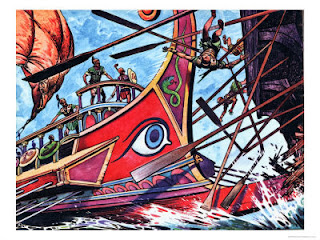 |
| One giant leap for mankind |
If the ships have no railings such as Olympias is today, then an athletic young warrior could leap from deck to deck, his reception notwithstanding. However, it would appear that the usual state for a warship in combat was to have railings and even a line of shields mounted on it too. This means the process of climbing off one's own ship and onto the other is much more difficult.So much so that I begin to think that it was rarely on the cards.
 |
| Great ! Now lets try it one more time, at sea, in armour, with a shield and spear, and someone is shooting at you.... |
One would imagine that ships locked together after collision or press of battle would be more vulnerable to enemy clambering onboard.
However. usually the distance between ships was not negligible. The ram held the target ship at a distance. Oars, even broken, would hold the enemy ship away so it could not lie immediately alongside. Here is one way the oarsmen could contribute to a fight - by holding the opposing ship off with their oars. The sailors were divided into two teams to mange th efore and aft-ship , Polybius says they had poles/boathooks with which they could fend off other ships to avoid collisions. The usual case would require a leap to gain the other ship. The paraxeiresia / outrigger would be another gap to be crossed - Brasidas fell into the outrigger during fighting at Pylos (also an example that shows a trierarch probably wore military gear).
 | |
| Brasidas stands on the outrigger he should fall through (because it should not be boxed-in), on a Roman ship from 300 years later. But he cuts a fine figure anyway. |
The corvus was an interesting innovation, not only because it locked the target ship onto the attacker but also because it provided a funnel to pour deck troops onto the enemy ship so that a more regular combat could take place. Its genius is that it solves the two main problems with getting a good solid melee going at sea (which the Romans thought they would usually win) - First problem was to have a solid hold on the enemy ship and the second was to provide a secure footing for attacking marines.
The Persians had circa 40 deck troops on their ships at Salamis according to Herodotos. Many writers assume this is a loading of the ship with marines a la the Roman tactic. But there was no equivalent of the corvus, no mention of gangplanks, even (though a trireme should carry two boarding ladders - for crew embarkation). We also know that the Persian style of fighting called for maximum use of the bow and then a short spear when things got to close quarters. The Greeks were contemptuous of their poor armour and shields. The fighting at Platea illustrates this, where the Persians were admired for their courage but almost pitied for their lack of skill and coordination.
 |
| Nice clothes shame about the relatively low combat efficiency against western heavy infantry. |
 |
| 'Then we die in the shade !' |
In addition, if the Persian ships had a high side as many suggest with reference to the Sennacherib reliefs, then clambering over them to board anenemy made things even more difficult. Why bother ? Just shoot his deck troops and commanders down then waltz over afterwards.
Diodoros - at a later date - tells of javelins and special long spears being used at distance and then swords when the combatants were at each others' throats.
 |
| Even at a later date the value of a long spear for boarding was appreciated : RN 19th century boarding pikes |
 |
| How NOT to greet an oncoming rammer : I hope they can swim. |
 |
| He he..good old 'Look and Learn' |
As an aside, the Osprey illustration of a 'grappler' working from within the oarsmen's space does not allow for the closeness of the oarsmens positions nor the chaos he could cause by being there. He would stop at least 2 and maybe 6 men using their oars.
An attack with the intention from the outset to grapple and capture the enemy ship is more likely to be conducted like a classic pirate ship action from Hollywood, with ships lying abeam. With the ship approaching the target to lie parallel gunwale to gunwale so its own marines can together jump over to the target ship.
 |
| Pirates and RN fight it out : gunwale -to-gunwale |
A final juicy picture from 'Look and Learn'. If the ancient world did not look like this then it ought to have...
 |
| Osprey eat your hearts out.. |
No comments:
Post a Comment